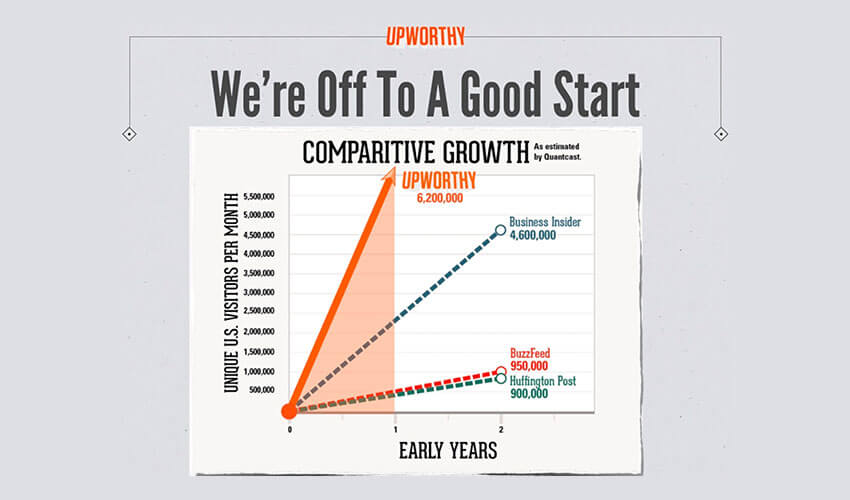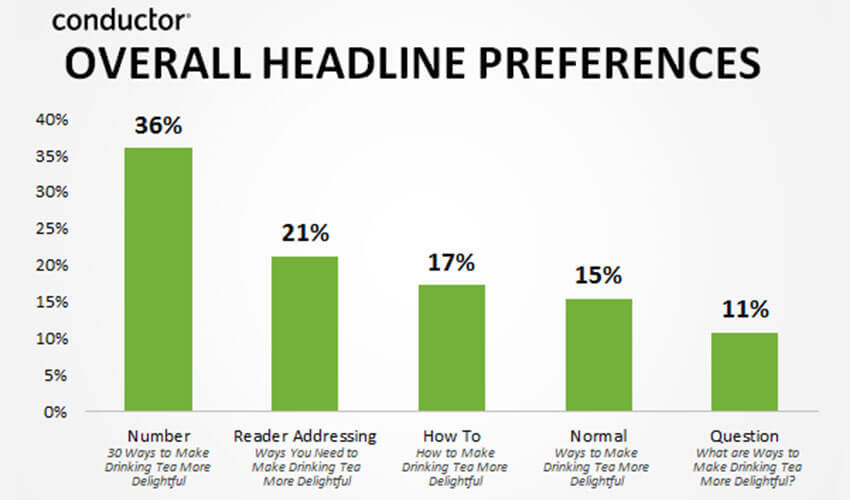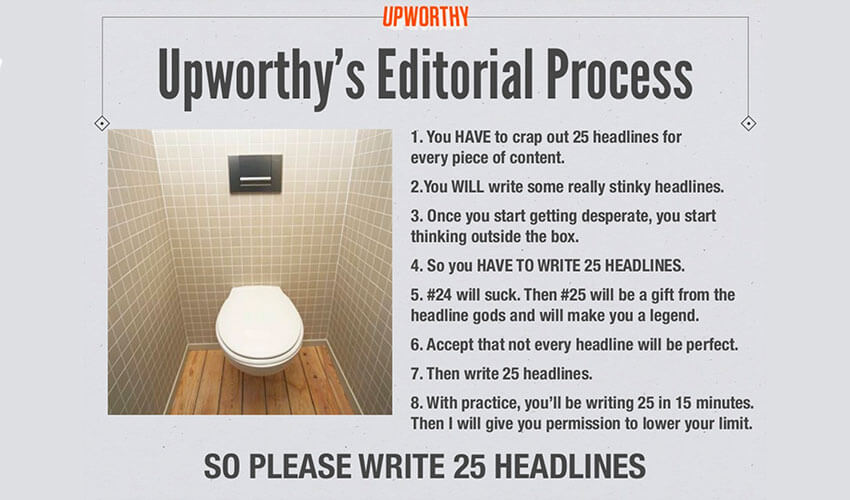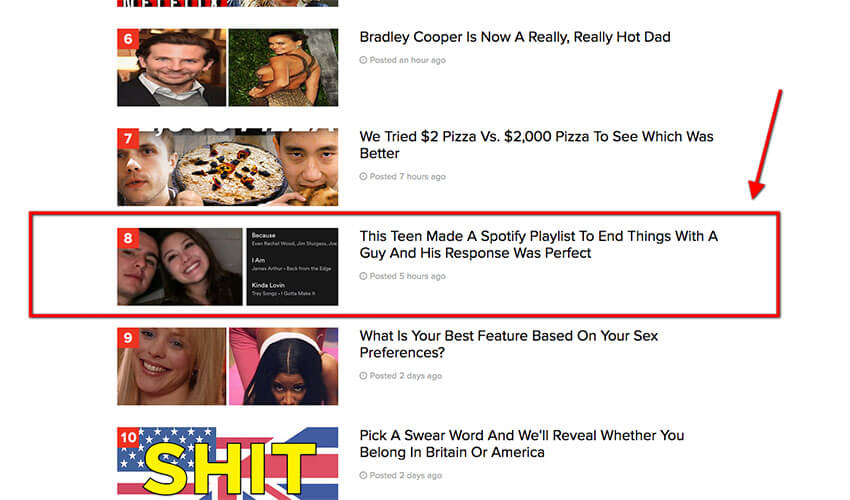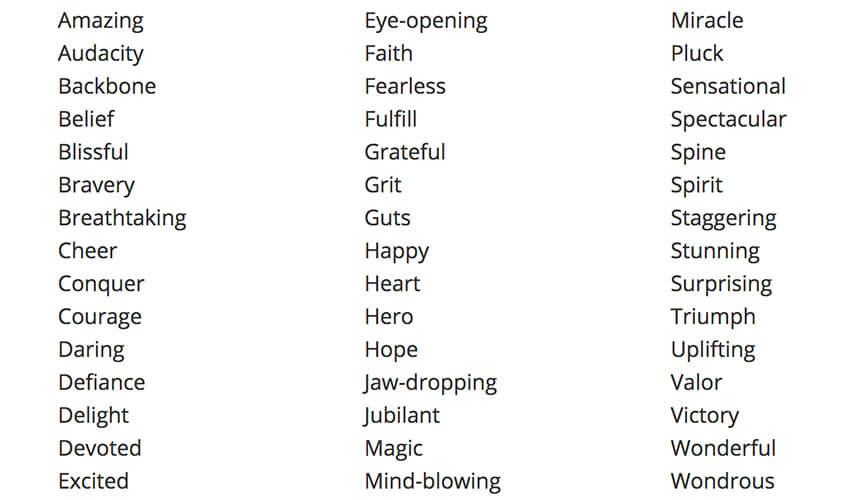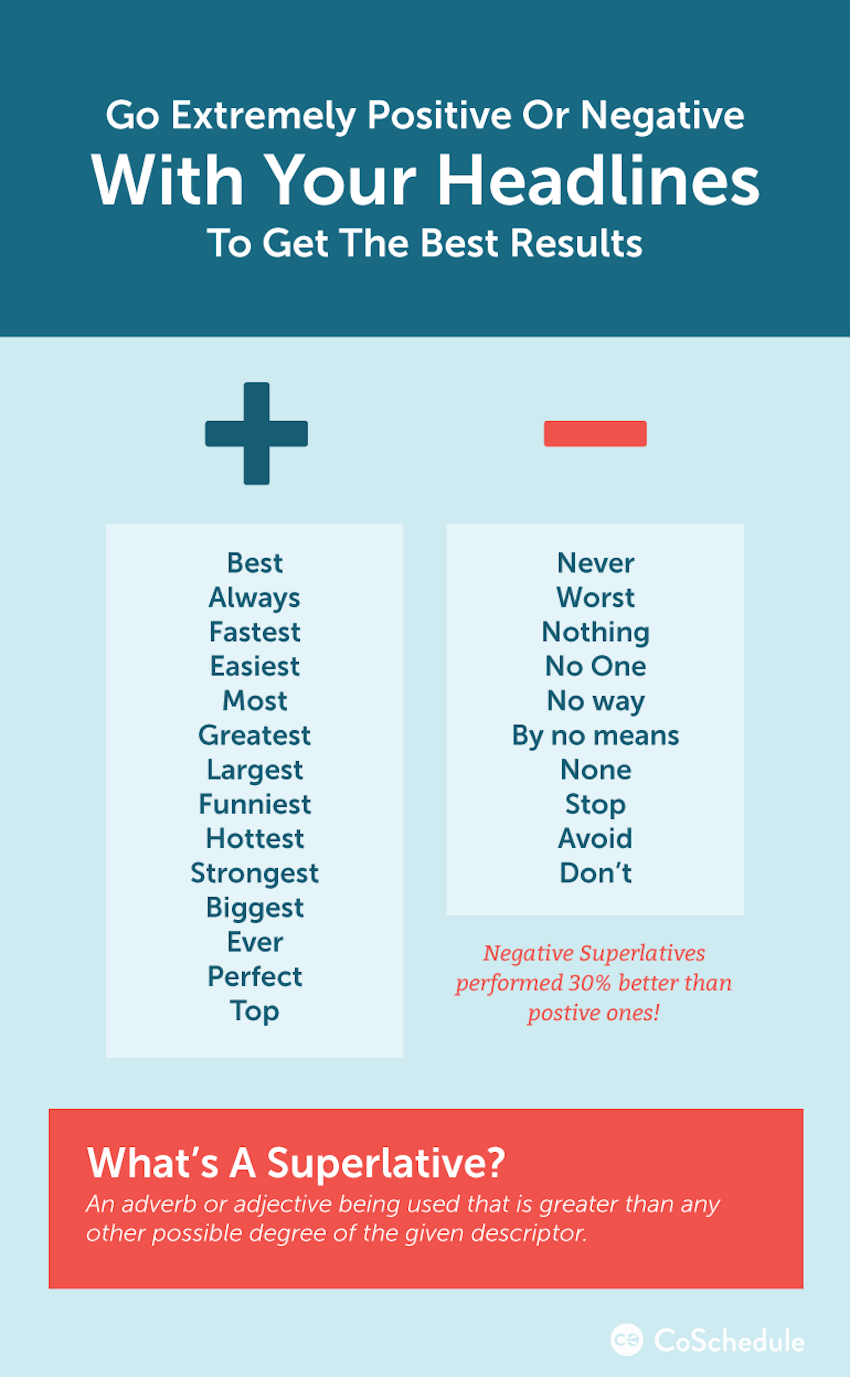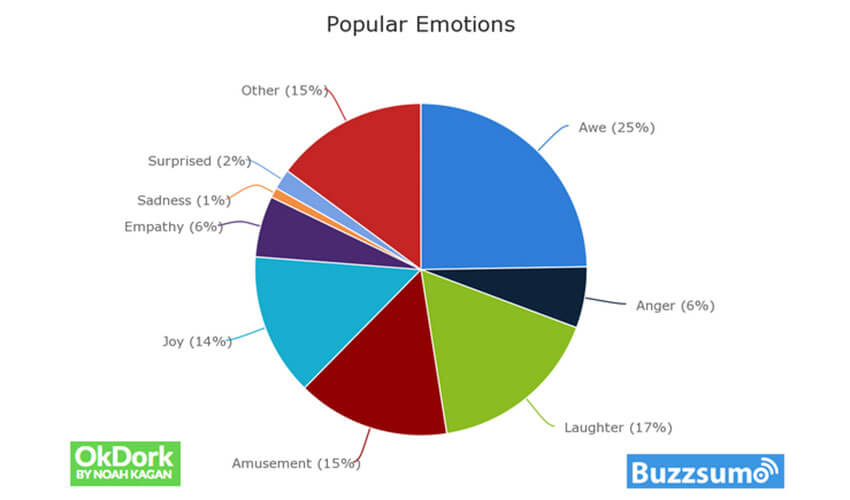David Ogilvy, the father of advertising, once said, “On the average, five times as many people read the headline as read the body copy. When you have written your headline, you have spent eighty cents out of your dollar.”
It’s been awhile since he said that but the words still resonate with us. According to Copyblogger, 8 out of 10 people will read a headline, but only 2 out of 10 will read the rest of the article. Imagine, if you could flip this number on its head by boosting your headline’s performance. That would change everything.
Crafting a high-performing headline that is not click-bait but is also incredibly alluring is no easy task. But once you wrap your head around the different creative strategies, you’ll be much more confident about publishing your content to the world wide web.
Upworthy.com have demonstrated what crafting intuitive, intriguing and unexpected headlines can result in. The site’s explosive growth is for the most part attributed to the team’s unbeatable headline crafting skills. Yes, the data is real!
Image Source: The Sweet Science of Virality
Now, let’s explore the different ways of writing irresistible headlines.
Use specific numbers & data in your headlines
Numbers are proved to be one of the best triggers to hook the reader’s interest. For several reasons, our brain is attracted to numbers, and we just can’t help ourselves when we see a carefully constructed headline using a numeral.
Using real headlines from Buzzfeed, The Huffington Post, and similar content sources, Conductor carried out a study to determine what type of headlines resonate most with readers. They divided the headlines into five high-level types:
- Regular (Ways to Make Drinking Tea More Delightful)
- Question (What are Ways to Make Drinking Tea More Delightful?)
- How to (How to Make Drinking Tea More Delightful)
- Number (30 Ways To Make Drinking Tea More Delightful)
- Reader-Addressing (Ways You Need to Make Drinking Tea More Delightful)
What they found confirmed the growing suspicion that numbers are vital to grabbing people’s attention. Number headlines outperformed the second most popular type by 15%.
Image Source: Moz blog
What is it that makes the number headlines so attractive? There is more than one reason.
- The promise of something substantial. When you’re on the lookout for something specific, and you’re scouring the internet for real advice, there’s nothing more annoying than clicking on a perfect-sounding headline only to find out it has nothing to do with the rest of the article. But number headlines make a promise that the author will offer more than one idea or solution within the article, so the chances of finding something useful are much higher.
- The convenience of speed reading. Again, if you’re scanning the internet in search of an answer to a specific question, you don’t necessarily want to spend 20 minutes reading the whole article to find one or two relevant sentences. Number headlines suggest that the article is scannable and won’t take too much time to digest.
- The simplicity of numbered structure. Writing eloquently and making smooth transitions from one point to another is not always easy – ideas can quickly get lost in the babble. Numbered headlines guarantee at least some measure of structure and flow, which gives readers the confidence to click through and easily find what they’re looking for.
- It’s the preferred way of receiving and organizing information. In this New Yorker article, Maria Konnikova shows how lists hit our “attentional sweet spot.” We process the information we receive spatially because that makes it much easier to recall it later on. That’s why we write shopping lists, and to-do lists the way we do – even if we lose that piece of paper, our brain can still recall the information based on its location on the paper. Besides that, lists also appeal to our “general tendency to categorize things”. In fact, we’re struggling not to categorize things even when we make an effort to leave something unlabelled.
But what makes lists truly appealing in the current media environment, where people are overwhelmed by the amount of content, is their promise of a definite ending. The alluring and reassuring certainty that we know what we’re in for also triggers the anticipation of pleasure associated with completing a task. So, really, listicles are a sort of brain candy that online readers simply can’t resist.
[optin-monster-shortcode id=”wqwp7kre2udnzd6c”]
In case the listicle structure is not suitable for the piece of content you’re working on, another click-enticing element you can include in your headline is data. Adding “Backed by research” or “Backed by science” to support your claim can significantly boost the credibility and appeal of a headline. Readers love the promise of solid, evidence-based content that they can trust and share with their network.
Craft a unique headline
Let’s say that a headline is like a tip of an iceberg. These few words will determine whether the main chunk of your content is read or ignored, so don’t feel like you’re wasting your time writing and rewriting headlines. It takes more than a few tries to capture the essence of your article in an irresistible way. And even more so if you’re determined to craft a unique one.
Upworthy.com, who are notoriously skilled at constructing killer headlines, generate more than 3 million unique visits per month. And as insane as it sounds, they credit most of the success to their unique, inventive headlines that poke at readers’ curiosity.
Have I got your attention yet? Good, because the most important part of the Upworthy.com story is this – their editorial team writes at least 25 headlines before settling on the winner.
In their slide presentation The Sweet Science of Virality, Upworthy.com share their creative process and outline the most important steps to crafting high-performing headlines and content. But there’s one idea that keeps on resurfacing:
“It doesn’t matter how good your content is. If you don’t make it compelling enough to click, no one will know it exists.”
And here’s Upworthy’s editorial process that they follow to write really damn good headlines.
Image Source: The Sweet Science of Virality
Jotting down your best (25) ideas is the first step to writing a unique headline. Once you think you have the one, it’s important to verify its uniqueness quickly. Remember, there are no new ideas in this world, so it’s very likely someone’s already snatched that headline before you. The easiest way to check whether your headline is as unique as you think it is is to ask almighty Google. Type your headline in the search bar, enclose it in double quotation marks, hit search and wait for the moment of truth.
Check what people are seeking for
If we go back to the headline being a “tip of an iceberg” metaphor, its relevance and topicality are crucial to tap into trends and capture a decent amount of traffic. To entice browsers to click on your headline you must use the language, style, and tone that’s most appealing to your target audience.
The best way to get a sense of how your audience talks and what specific words they use is by joining the discussion on social media or sites like Quora. Get involved and analyze the type of questions, ideas, and topics being tackled by your ideal readers to ensure the headlines you craft hit the bullseye.
Google autocomplete is also a smart way to identify keyphrases that your headlines need to include. Orbit media suggest that using a colon to combine search-friendly and social-friendly phrases can lead you to the perfect headline, as it gives prominence to the keyphrase but also leverages the human psychology. Here are a few examples of this writing tactic:
- How to Research Keywords: Tips, Competition, and Squirrels
- Competitive Analysis Tools: 5 Free Ways to See the Analytics of Any Website
- Neuromarketing Web Design: 15 Ways to Connect with Visitors’ Brains
- Internal Linking: 9 Best Practices for Internal Links
- Ego Bait: 5 Simple Ways to Leverage Blog Mentions
- Thank You, Pages: 9 Example of Missed Opportunities
Make it targeted and specific
If you want your content to be picked up by search engines, incorporating target keywords into your headlines is a must-do. Follow the best on-page SEO practices when crafting a headline to make sure it’s not only unique but also optimized for search.
When creating content for the web, identifying target keywords should be your starting point. It’s the only way to get in front of the right audience and generate traffic. The trick here is to find the balance between creating something that’s findable and content that’s valuable enough to be sought out by your audience.
To indicate relevance to search engines and give prominence to the target keyphrase, ensure you place it at the beginning of the headline.
Do you have a CRM that keeps you organised?
The most user-friendly CRM on the market. 14-day free trial.
Start Free TrialPainless setup, no credit card required
Raise a question
The magic of question headlines comes from tapping into your reader’s concerns. With mobile search taking the lead, people are increasingly searching by voice, which means they’re asking complete, full-sentence questions and are using natural language when doing so. Google uses something called “semantic indexing” to understand the content of an article, so if you use a question in your headline and provide a complete answer in the article, chances are the search engine will connect people to your content.
Another huge benefit of question headlines is their power to intrigue the reader and cause their mind to engage in a sort of silent conversation. Once they read a question headline, readers can’t help but try to answer it in their head or start wondering what the real answer is and click through.
Both open-ended and closed-ended questions can increase the effectiveness of your headline, and you can also experiment with the colon trick recommended by Orbit Media to combine the target keyphrase or question that will make it findable with something more appealing to humans.
Create curiosity and urgency
Headlines that leverage human psychology are always incredibly powerful. If you find a way how to trigger curiosity or evoke urgency, it’s almost guaranteed that people will give in and click through. Obviously, your content must match your headline, or you’ll make plenty of enemies very quickly.
So how do you create curiosity? It’s not a precise science, and there’s no formula how to hook a reader instantly, but one of the most effective methods is not to give everything away in a headline.
Image Source: BuzzFeed
That curiosity gap will be what drives people to your website and hopefully leads to a sale at some point in their journey (or make them come back for more similar content in the future).
The curiosity-gap approach can easily be overdone though, so stay honest about what your readers can actually expect from the content and avoid any click-baiting games. Lying to your readers will only work once, and then you’re in big trouble.
The urgency factor can be a game changer, too. Nothing makes people act faster than the fear of losing out on a good deal or missing their chance to see, hear or download something that’s available for a limited time only. If you’re making a limited offer, be sure it’s reflected in the headline to compel people to take action immediately.
Focus on benefits or loss
Using a headline to state the biggest benefit or loss your readers might experience is a great way to find and address the right audience. This headline style has the best chance of making a long-lasting impression on a reader even if they don’t click through immediately. Since headline is the hook that will determine whether your content is consumed, it’s a good idea to transform the biggest benefit (or loss) that your post offers into a headline. We’ve already discussed people’s unwillingness to spend more time reading something that they don’t find useful, so writing a headline like this will give them the confidence to click and read.
One of the greatest benefits of this style is that even if they don’t visit your site to read the article, they’ve at least laid eyes on your best selling point.
Use power words
Some words attract more shares and likes; other generate better traffic. Since headlines need to fit a certain length to perform well, word choice is truly critical to squeeze the most out of your headline. A lot of research has gone into determining what words elicit readers and have the potential to drive more traffic.
Employing power words is a surefire method to grab people’s attention and get them excited about reading the whole article.
Here are some research-backed power words that have been shown to achieve the best results:
- Words that increase clicks from search results: why, best, tricks, how to, free, you, blog post, great;
- Words that get more retweets: you, Twitter, please, retweet, post, blog, social, free, media, help;
- Words that appear most often in viral posts: smart, surprising, science, history, hacks (hacking, hackers and “life hack” related topics), huge / big, critical;
- Negative words that are most appealing (negative words that appear in viral posts): Kill, Fear, Dark, Bleeding, War;
Power words are simply emotionally impactful words that can make people cry, laugh or ponder. Charging your headline with a couple of power words will make it stand out more, so spend a few minutes searching for a less commonly used but just as effective combination:
Image source: SmartBlogger
Run numerous A/B tests
As with everything online marketing, testing is an instrumental process that should never be ignored. You may think a headline is too small of an element to run A/B tests on and who has time for that anyway? However, ensuring your headlines are polished to perfection and have the capacity to drive a decent amount of traffic will make your content creation efforts worthwhile.
One of the main tips from the Upworthy.com editorial team was to test the hell out of those headlines that made it to the top of your list and choose the one that clearly outperforms the rest. With the data obtained from A/B tests, you will quickly learn to write headlines targeted specifically at your audience, in the right style, tone and using the right language.
Make a bold statement evoking an emotion
People connect with emotions, not words. Studies have shown that viral content tends to be emotionally complex, often invoking strong positive or negative feelings, such as happiness, admiration, anger or fear. It’s been demonstrated numerous times that people are more likely to click, read and share content that pulls at their heartstrings, so packing your headline with words that elicit feelings will lead to increased virality and reader engagement.
[optin-monster-shortcode id=”rs4shvbsq8bjva7m”]
CoSchedule found that negative superlatives performed 30% better than positive ones, but be sure to run your own A/B tests before letting the content out into the world.
Image source: CoSchedule
BuzzSumo analyzed top 10,000 most shared articles on the web and used a categorization system to map each color to emotion, like joy, sadness, laughter, amusement, etc.
Here’s the breakdown of emotions:
Image source: okDork
Positive emotions are clearly leading the headline optimization race, so it’s best to focus on crafting content that has the power to surprise people, make them laugh or drool in admiration.
Get crafting
We have only scratched the surface on the number of headline writing tips available online. They’re all tried and tested by online marketers, but no one has the formula for writing killer headlines that go viral. Great headlines are a mixture of creativity, honesty, and surprise and often take almost as much time to write as the content itself. So use Upworthy.com advice and start writing a minimum of 25 headlines for each article until you hit the jackpot. As they say, 24 out of 25 headlines will be stinky, but the winning one will make you glad you tried.

